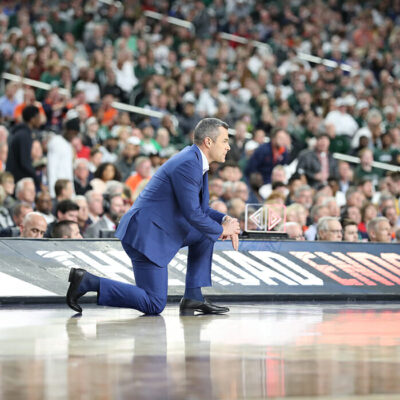This story is part of our 2014 health issue, which also includes articles on mammography, rhabdomyolysis, and gluten intolerance.
Helmet? Check. Shoulder pads? Check. Tiny biometric brain injury sensor? Check.
You won’t see the quarter-sized computerized devices tucked behind their ears, but more than 100 local high school and college athletes are donning the sensors during games and practices as part of UVA’s latest push to understand what happens when a player’s brain receives a concussion.
Dr. Jason Druzgal, a neuroradiologist at the University, is leading the charge.
“Part of the problem is there’s not a great consensus about how to manage concussions after the fact,” said Druzgal. “We do know that if they’re managed inappropriately and someone is returned to play too soon, they have an increased risk for a subsequent concussion. And that’s a real problem. We need better tools to determine when people should be cleared to return to play.”
The cause for concern is evident, as a growing number of professional athletes have begun to link their brain injuries to an increased risk of dementia, Lou Gehrig’s disease, Alzheimer’s, depression, and even suicide. More than 4,500 current and former NFL players are in the midst of an ongoing $765 million lawsuit against the league, fueled by accusations that the organization withheld information and research about how concussions affect brain function in the short and long term.
Shari Benson, the head athletic trainer for St. Anne’s-Belfield (STAB), knows full well the extent of concussion concern among parents and athletes, which is why she urged about 15 football players at STAB to participate in the UVA study last fall. About 60 UVA football, soccer, and lacrosse players also volunteered for the study.
“I can’t talk to a parent in this school without concussions coming up,” said Benson. “Even after a basketball game, people will say, ‘Well, I’m glad it was a concussion-free game.’”
Science has made great strides recently in documenting concussions, but only after they occur. And over the last several years every Virginia high school and college has implemented a series of intricate post-concussion cognitive tests to ensure athletes return to normal levels of brain functioning before they are allowed to play again.
But the initial diagnosis is patently difficult, according to UVA football’s athletic trainer Kelli Pugh. It largely relies on players voluntarily coming forward with potential symptoms, which they know could land them on semi-permanent hiatus from playing the game they love as they undergo a series of treatment options that aren’t well founded either. And players like to play, not sit on a bench.
“You’re typically giving those tests to someone after they’ve reported symptoms. With this research study, one of the questions they hope to address is how to accurately diagnose concussions, so we don’t just have to rely on someone coming in with a headache or a teammate telling us to check on a guy,” said Pugh. “We’re trying to help people be safe and move the science forward on concussions, because really the only treatment we have at this point is rest.”
The UVA study aims to tread where no study has before. Researchers take a baseline MRI (magnetic resonance imaging) test of each player at the beginning of the sports season and another one at the end, so they can compare the two.
Other studies have rarely used the participants’ own baseline MRI results as a basis for comparison. Instead, they compare the subject’s post-concussion brain function to another person’s “normal” brain function, which creates a flawed scope of results, according to Druzgal.
Concussion studies in the past have also not bothered to measure or record the severity of the actual hit that causes the brain injury, relying instead on the subjective recollections from the players themselves. But every hit an athlete takes is slightly different, as is their experience of it, which makes for flawed scientific findings, said Druzgal.
And so the UVA study measures each crushing blow players receive by using a tiny computer device about the size of a quarter that attaches to the skin behind their ear with an adhesive patch. Before UVA football practices and games, the researchers “tape up” with the players, quietly affixing the sensors, which they retrieve afterwards as the players come off the field.
The device—made by X2 Biosystems and already used by several college and NFL teams around the country—senses, measures, and records rotational and linear movements, so after a sharp hit during a game or practice, the researchers plug the device into their computers and gauge the severity of the impact. They later will correlate and map those hard hits to any changes in brain function that appear on the players’ two MRI results.
It became so routine for the players to wear the devices that some of the STAB participants forgot to take them off after they finished playing, said Benson.
Both athletic trainers—Benson and Pugh —have high hopes for what the study will unveil, as does Charlottesville High School football coach Eric Sherry. All three have experienced a growing reluctance by either players, or their parents, to join the football team as the national attention on concussions has grown.
Sherry recalled one of his players who complained to a teacher of a pounding headache during class. And because he was on the football team, he was immediately sent for an evaluation to see if he had a concussion. In reality, Sherry said, the kid hadn’t eaten anything all day, causing his blood sugar to drop and a headache to set in.
“I really think they have to give it time to let the science grow with it because you can overreact,” said Sherry. “I understand you want to err on the side of caution. But you also have to be careful not to overdo it because then you dilute the whole results about what is and isn’t a concussion.”





